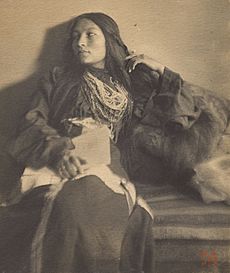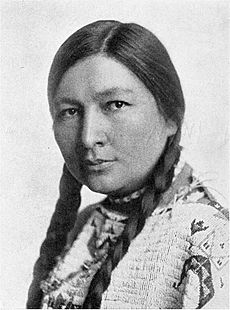Zitkala-Sa facts for kids
Quick facts for kids
Zitkala-Ša
|
|
|---|---|
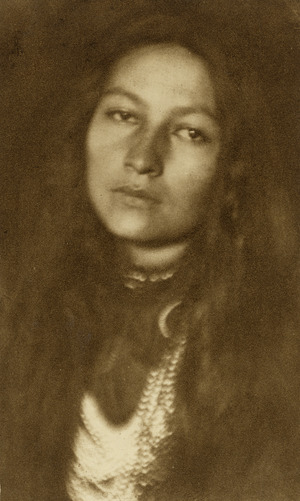
Zitkala-Ša in 1898, National Portrait Gallery, Smithsonian Institution
|
|
| Born | February 22, 1876 |
| Died | January 26, 1938 (aged 61) |
| Resting place | Arlington National Cemetery |
| Other names | Gertrude Simmons Bonnin |
| Education | White's Manual Labor Institute, Wabash, Indiana |
| Alma mater | Earlham College |
| Occupation |
|
| Employer | Carlisle Indian Industrial School, Bureau of Indian Affairs, Uintah-Ouray reservation |
| Known for | Co-composed the first American Indian opera, founded the National Council of American Indians, authored books and magazine articles |
|
Notable work
|
Sun Dance Opera, Old Indian Legends, American Indian Stories, "Oklahoma's Poor Rich Indians" |
| Spouse(s) | Raymond T. Bonnin |
| Children | Ohíya |
| Parent(s) | Mother, Ellen Simmons, also called Thaté Iyóhiwiŋ ("Every Wind" or "Reaches for the Wind") |
| Signature | |
Zitkala-Ša (pronounced Zit-KAH-lah-Shah) was a brave and talented Yankton Dakota woman. Her name means Red Bird in the Lakota tongue. She was born on February 22, 1876, and passed away on January 26, 1938. She was also known by her English name, Gertrude Simmons Bonnin.
Zitkala-Ša was many things: a writer, editor, musician, teacher, and a strong activist for Native American rights. She wrote about her personal struggles. She felt torn between the majority culture where she went to school and the Dakota culture she grew up in. Her books helped share traditional Native American stories with many English-speaking readers.
In 1926, she helped start the National Council of American Indians. This group worked to get United States citizenship and other civil rights for Native people. Zitkala-Ša led this council until she died. Many people see her as one of the most important Native American activists of the 20th century. She also worked with musician William F. Hanson. Together, they created The Sun Dance Opera (1913). This was the first American Indian opera, based on Sioux and Ute cultural themes.
Contents
Growing Up and Getting an Education
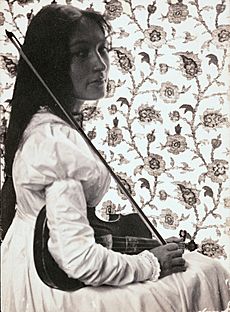
Zitkala-Ša was born on February 22, 1876. Her birthplace was the Yankton Indian Reservation in South Dakota. Her mother, Ellen Simmons, raised her. Her Dakota name was Thaté Iyóhiwiŋ, meaning "Every Wind." Her father, a Frenchman, left the family when she was very young.
For her first eight years, Zitkala-Ša lived happily on the reservation. She felt safe and free with her mother's people. In 1884, when she was eight, missionaries came to the reservation. They took several Yankton children, including Zitkala-Ša, to a boarding school. This was the White's Indiana Manual Labor Institute in Wabash, Indiana. It was a Quaker school.
Zitkala-Ša stayed at the school for three years. She wrote about this time in her book, The School Days of an Indian Girl. She felt very sad when her heritage was taken away. She was forced to pray as a Quaker. They also cut her long, traditional hair. But she found joy in learning to read, write, and play the violin.
In 1887, Zitkala-Ša went back to the Yankton Reservation. She lived with her mother for three years. She realized she no longer fully belonged there. Many people on the reservation were changing to fit white culture.
In 1891, at age fifteen, she decided to return to the White's Institute. She wanted more education than just becoming a housekeeper. She studied piano and violin. She even taught music there when the teacher left. In 1895, she gave a speech about women's rights. The local newspaper praised her speech.
Her mother wanted her to come home after graduation. But Zitkala-Ša chose to go to Earlham College in Richmond, Indiana. She received a scholarship. She felt lonely at first among mostly white students. But she showed her speaking skills with a speech called "Side by Side." During this time, she collected traditional stories from Native tribes. She translated them into Latin and English for children. In 1897, she had to leave college due to illness and money problems.
Music and Teaching Career
From 1897 to 1899, Zitkala-Ša studied violin in Boston. In 1899, she started teaching music at the Carlisle Indian Industrial School in Pennsylvania. She also led discussions about how Native Americans were treated.
In 1900, she played violin with the Carlisle Indian Band in Paris, France. That same year, she began writing articles about Native American life. These were published in famous magazines like Atlantic Monthly and Harper's Monthly. She wrote about the problems with American Indian boarding schools. She showed how Native children lost their culture there. This was different from what most other writers said at the time.
In 1901, Zitkala-Ša visited the Yankton Reservation. It was her first visit in years. She was sad to see her mother's house in bad shape. Her brother's family was poor. White settlers were taking land given to the Yankton Dakota.
When she returned to Carlisle School, she disagreed with its founder, Colonel Richard Henry Pratt. She did not like his strict plan to make Native Americans act like white people. She also felt the school only prepared Native children for low-paying manual jobs. In 1901, she published a story in Harper's Monthly. It was called "The Soft Hearted Sioux." It described a Native American boy losing his identity at the school. Pratt called her story "trash." Soon after, Zitkala-Ša was fired from the Carlisle School.
She then took a job as a clerk at the Standing Rock Indian Reservation. She likely met her future husband there.
Marriage and Family Life
Zitkala-Ša went back to the Yankton Reservation after Carlisle. She took care of her sick mother. Their relationship was difficult because her mother disagreed with Zitkala-Ša's choice to keep studying. During this time, she also collected traditional Sioux stories. These were for her book, Old Indian Legends.
In 1902, she married Raymond Talephause Bonnin. He was part Yankton and part European. He also followed Yankton culture. Soon after they married, Mr. Bonnin was sent by the Bureau of Indian Affairs to the Uintah and Ouray Indian Reservation in Utah. They lived and worked there with the Ute people for fourteen years. Their only child, Raymond Ohiya Bonnin, was born during this time.
Writing and Political Work
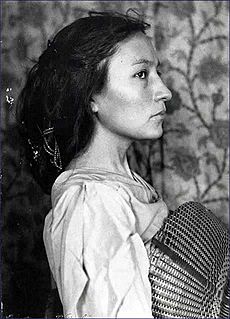
Zitkala-Ša had an important writing career. Her first period of writing was from 1900 to 1904. She published Native American legends and stories about her own life. She wrote more later, but these were not published until after she died. These included the words for The Sun Dance Opera. They were collected in 2001 as Dreams and Thunder.
Her articles in the Atlantic Monthly included "An Indian Teacher Among Indians." She also wrote "Impressions of an Indian Childhood" and "School Days of an Indian Girl." In Harper's Monthly, she published "Soft-Hearted Sioux" and "The Trial Path." In 1902, she wrote "Why I Am a Pagan" for Atlantic Monthly. This essay explained her personal spiritual beliefs. She showed that Native Americans did not always accept Christianity.
Much of her writing shows a struggle. She felt pulled between old traditions and new ways. She also balanced writing about literature and politics. This struggle made her work powerful.
Her second writing period was from 1916 to 1924. She focused on political writings. She and her husband moved to Washington, D.C.. There, she became very active in politics. She published important works like American Indian Stories (1921).
She also helped write Oklahoma's Poor Rich Indians (1923). This important pamphlet exposed how Native Americans were being cheated. She also started the Indian Welfare Committee. This was part of the General Federation of Women's Clubs. She worked as a researcher for this group in the 1920s.
American Indian Stories
American Indian Stories is a collection of writings. It includes stories from her childhood and essays. Many of these were first published in Harper's Monthly and Atlantic Monthly. This book came out in 1921. It told about the difficulties she and other Native Americans faced. They went to missionary and manual labor schools. These schools tried to "civilize" them and make them fit into the main culture.
Her autobiography in the book compared her happy early life on the reservation. She then described the "iron routine" of the boarding schools. Zitkala-Ša wrote that her "Indian nature" was like a "moaning wind." She said it came out like "the low voice of a curiously colored seashell." This voice was only for those who truly cared to listen.
Old Indian Legends
The Boston publisher Ginn and Company asked her to write Old Indian Legends (1901). This book collected stories she learned as a child. It also had stories she gathered from other tribes. The book was mainly for children. It aimed to save Native American traditions and stories. It also wanted to gain respect for Native cultures from European-American people.
"Oklahoma's Poor Rich Indians"
One of Zitkala-Ša's most important political writings was "Oklahoma's Poor Rich Indians." The Indian Rights Association published it in 1923. The article showed how some American companies were cheating Native American tribes. They used illegal ways, like robbery and even murder. This happened especially to the Osage people. Oil was found on their land. Criminals tried to take their rights to the oil money. Many Osage people were murdered in the 1920s.
This work helped Congress pass the Indian Reorganization Act of 1934. This law encouraged tribes to restart their own governments. It also helped them manage their lands. The government returned some lands to them.
Articles for American Indian Magazine
Zitkala-Ša was an active member of the Society of American Indians (SAI). This group published American Indian Magazine. From 1918 to 1919, she was the editor of the magazine. She also wrote many articles for it. These were her most direct political writings. They covered topics like Native American soldiers in World War I. She also wrote about land issues and problems within the Bureau of Indian Affairs (BIA). Some people later criticized her political writings. They felt she favored making Native Americans too much like mainstream Americans. But she wanted Native American culture to be recognized. She also pushed for US citizenship rights. She believed this would give Native Americans power and help protect their cultures.
Creating an Opera
While living on the Uintah-Ouray reservation in Utah, Zitkala-Ša met William F. Hanson. He was a music professor at Brigham Young University. In 1910, they began working together on The Sun Dance Opera. Zitkala-Ša wrote the story and songs for it. She played Sioux melodies on her violin and flute. Hanson used these melodies to create the music. The opera was based on the Lakota Sun Dance. The government had forbidden the Ute people from performing this dance on the reservation.
The opera first opened in Utah in February 1913. Ute people from the nearby reservation performed dances and some parts. Non-Native singers played the main roles. Historian Tadeusz Lewandowski says it was the first Native opera. It opened in Vernal, Utah, and received great praise. Few Native American operas since have focused so much on Native American themes.
In 1938, the New York Light Opera Guild presented The Sun Dance Opera. It was their opera of the year at The Broadway Theatre.
Political Activism and Legacy
Zitkala-Ša was politically active for most of her adult life. On the Uintah-Ouray reservation, she joined the Society of American Indians (SAI). This group worked to keep Native American ways of life. They also pushed for full American citizenship rights. Zitkala-Ša became SAI's secretary in 1916.
Zitkala-Ša and her family moved to Washington, D.C., in 1916. As SAI's secretary, she wrote to the Bureau of Indian Affairs (BIA). She began to criticize the BIA's practices. For example, they tried to stop Native American children from using their languages in boarding schools. She also reported abuse when children refused to pray in a Christian way.
From Washington, Zitkala-Ša gave speeches across the country for SAI. She wanted to raise awareness about Native American culture and identity. In the 1920s, she promoted a movement to unite all American tribes. They worked to gain citizenship rights. In 1924, the Indian Citizenship Act was passed. This law gave US citizenship to most Native peoples who did not already have it.
Even with citizenship, Native Americans still faced discrimination. In some states, they could not vote. This did not fully change until the Civil rights movement of the 1960s. In 1926, she and her husband started the National Council of American Indians (NCAI). This group aimed to unite tribes to gain full voting rights. Zitkala-Ša was the president, main fundraiser, and speaker for the NCAI until she died in 1938.
Zitkala-Ša also worked for women's rights in the 1920s. She joined the General Federation of Women's Clubs (GFWC) in 1921. This group worked for women's concerns. Through the GFWC, she created the Indian Welfare Committee in 1924. She helped start a government investigation into how Native Americans in Oklahoma were being cheated. People were trying to steal their oil drilling rights and money. She gave speeches across the country. She called for the Bureau of Indian Affairs to be changed.
Zitkala-Ša also led a voter registration drive for Native Americans. She encouraged them to support the Curtis Bill. She believed it would help Indians. The bill gave Native Americans US citizenship. However, it did not give those on reservations the right to vote in local and state elections. Zitkala-Ša continued to work for civil rights. She also fought for better health care and education for Native Americans until her death in 1938.
Death and Lasting Impact
Zitkala-Ša passed away on January 26, 1938, in Washington, D.C. She was sixty-one years old. She is buried as Gertrude Simmons Bonnin in Arlington National Cemetery with her husband Raymond. Later, the University of Nebraska republished many of her writings.
A crater on Venus is named "Bonnin" in her honor. In 1997, she was named a Women's History Month Honoree. A park in Arlington County, Virginia, was renamed in her honor in 2020.
In 2018, the Melodia Women's Choir performed a new work called Red Bird. It was based on Zitkala-Ša's story.
Artist Chris Pappan created a Google Doodle for her 145th birthday on February 22, 2021.
Zitkala-Ša's impact continues today. She is seen as one of the most important Native American activists of the 20th century. She showed how to resist and how to bring about change. Through her activism, Zitkala-Ša made important improvements in education, health care, and legal rights for Native American people. She also helped preserve Indian culture.
Zitkala-Ša will be honored on an American Women quarter coin in 2024.
Writings by Zitkala-Ša
- Old Indian Legends. Lincoln: University of Nebraska Press, 1985.
- American Indian Stories. Lincoln: University of Nebraska Press, 1985.
- Zitkála-Šá. "Why I Am a Pagan." Atlantic Monthly, 1902.
- Zitkála-Šá, Fabens, Charles H. and Matthew K. Sniffen. Oklahoma's Poor Rich Indians: An *** of Graft and Exploitation of the Five Civilized Tribes, Legalized Robbery. Philadelphia: Office of the Indian Rights Association, 1924.
- Zitkála-Šá. Dreams and Thunder: Stories, Poems, and The Sun Dance Opera. Edited by P. Jane Hafen. Lincoln: University of Nebraska Press, 2001. ISBN: 0-8032-4918-7.
- Zitkála-Šá: Letters, Speeches, and Unpublished Writings, 1898–1929. Edited by Tadeusz Lewandowski. Leiden, Boston: Brill Press, 2018. ISBN: 978-90-04-34210-1.
Scores
- Hanson, William F., and Zitkala-Ša. The Sun Dance Opera (romantic American Indian opera, 1913, 1938). Photocopy of the original piano-vocal score, from microfilm (227 pp.). Library of Brigham Young University, Provo, Utah.
See also
 In Spanish: Zitkala-Sa para niños
In Spanish: Zitkala-Sa para niños
Images for kids


